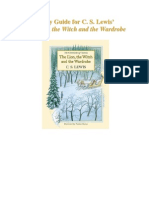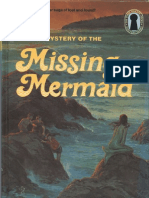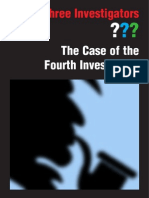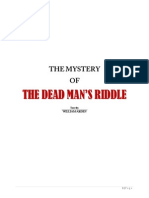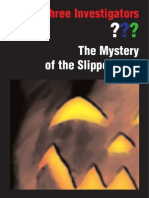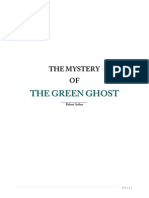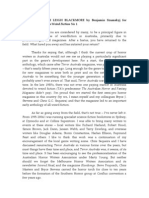The Three Investigators
The Three Investigators
Uploaded by
Atul YadavCopyright:
Available Formats
The Three Investigators
The Three Investigators
Uploaded by
Atul YadavCopyright
Available Formats
Share this document
Did you find this document useful?
Is this content inappropriate?
Copyright:
Available Formats
The Three Investigators
The Three Investigators
Uploaded by
Atul YadavCopyright:
Available Formats
???
The Three Investigators
by David Baumann and Seth Smolinske 8,570 words
approximately 4,613 words by Seth, or 53.8% approximately 3,616 words by David, or 43.5% 341 words in the titles of the books, or 2.7%
Seth Smolinske lives in Kendallville, Indiana, and is almost certainly the premier expert on the Three Investigators series in the United States. He has interviewed several of the authors and illustrators of the series, and visited sites associated with the late Robert Arthur who created it. Seth has amassed a large collection of Three Investigators books and memorabilia including original artwork, correspondence, and one original manuscript, and has helped many collectors acquire some of the volumes. As the astute reader will observe, most of the hard data and details in the following article came from him. However, he insisted that Davids name be listed first in the authors place since David outlined and edited the article, selected the illustrations, and put it into final form. David Baumann lives in Placentia, California, and is a long-time collector of series books and a frequent contributor to the Review. In nearly twenty years he has compiled a collection of about forty complete series. A few years ago he managed to place on his shelf the last of the Three Investigators forty-three original volumes in hardback.
INTRODUCTION
David: As I write, it is late winter in southern California. I live about an hours drive from the fictional locale of Rocky Beach, the hometown of Jupiter Jones, Bob Andrews, and Pete Crenshaw, the three investigators. It is heartily satisfying for me to read this series that is set in the place where I grew up. I recognize the mountain passes that appear often in the Three Investigators stories and am familiar with the thick coastal fogs that figure now and then in the mysteries. The frequent historical references to the Indian and Spanish presences a couple of centuries ago, and the geology of the beaches and the channel islands, put me right at home.
The settings in coastal towns, sprawling inland ranches and vineyards, and jaunts into Hollywood are journeys into my growing up years, although the placement of various communities and other sites is not quite true to the map. For the most part, though, the series is fully expressive of the California Hollywood and beach scenes of the 1960s to 1980s. I nod my head in recognition when I peruse the volumes. Rocky Beach is situated toward the south end of Malibu. There is a place there called Topanga Beach; topanga is an Indian word for rocky. However, as one of the writers of the series, Dennis Lynds, told me once, The problem with Rocky Beach is that [series creator] Bob Arthur located it, from mileage and proximity to Hollywood, at about Malibu, but Malibu couldnt possibly have all the features, the harbor, etc. So for the writers who lived in Californiame and M. V. Carey Rocky Beach tended to be based on Santa Barbara-Ventura. Santa Barbara was Lynds own residence, and is located about an hours drive northward along the coast from Malibu. Ventura lies between Malibu and Santa Barbara, and was the home of another Three Investigators author, M. V. Carey. The Three Investigators series is the only one in my collection introduced to me by one of my sons. When he was about twelve, Benjamin (now 28) urged me to read a paperback called The Secret of Skeleton Island (no connection to the Ken Holt volume of the same title). I did so and found the tale to be absorbing. When he was older he discarded the book. Years later I found it in a giveaway bag in our garage. I picked it up and placed it on my shelf where it now rests, honorably but anomalously, among the hardcover volumes in the series. Skeleton Island, however, is not the first book in the seriesits the sixth. The initial offering is called The Secret of Terror Castle. Published in 1964, it was the brainchild of the prolific Robert Arthur. He devised the concept and developed the characters of the forenamed young teens who are the three investigators. Each Three Investigators tale begins with an introduction, the first thirty of them purportedly by Alfred Hitchcock but actually written by the author. In the introduction to Terror Castle, we read, The three boys who call themselves The Three Investigators are Bob Andrews, Pete Crenshaw, and Jupiter Jones, all of
3 whom live in Rocky Beach, a small city on the shore of the Pacific Ocean some miles from Hollywood. Bob Andrews, who is small but wiry, is something of a scholarly type, although with an adventurous spirit. Pete Crenshaw is quite tall and muscular. Jupiter Jones is Well, I shall refrain from giving you my own personal opinion of Jupiter Jones. The introduction makes it clear that Hitchcock finds Jupe to be difficult. In fact, he refers to him as insufferable. This, of course, is meant to serve as part of the appeal to the reader. Introductions in subsequent books, however, are not so reticent. Jupe is described as a brainy boy and a fanatical reader with an almost photographic memory and an uncanny talent for deduction. He is also noted for being stocky, although most people would use the word overweight or other synonym. He is also frequently described as conceited. Nonetheless, he is endearing and definitely the power behind the Three Investigators undeniable successes. The unusually lengthy introduction to the fourth book in the series, The Mystery of the Green Ghost, in many ways reads as though it originally served as the bible for this series. Using excerpts from it and the other titles penned by Robert Arthur, we get good summaries of the boys personalities and the contribution each makes to the team: Jupiter Jones, First Investigator. Head of the firm and known for his remarkable powers of observation and deduction, he is stocky, muscular, and a bit roly-poly. He has a round face which often looks stupid but which hides a sharp intelligence. Jupiter has an excellent mind, and he is rather proud of it. He has many good features, but undue modesty is not one of them. He was also a famous child actora fact he is not comfortable with as a teenagerand still retains exceptional skill in acting. Pete Crenshaw, Second Investigator. Tall and muscular, sturdy and courageous, he excels at athletics. Inclined to nervousness before anything happens, but a tower of strength in any kind of trouble. He is Jupiters right-hand man when it comes to trailing suspects and other dangerous activities. Petes father is a special-effects man who works at one of the movie studios in Hollywood. Bob Andrews, Records and Research. Slight of build, small but wiry. Studious in nature, he is something of a scholarly type with an adventurous spirit. He has great nerve and the courage of a lion. Adept at research, he works parttime at the local library, which enables him to hunt up information needed for their investigations. Bobs father is a feature writer for a big newspaper in Los Angeles. It was Jupiter who designed the business card that the boys use, as recounted in the first chapter of the first book:
4 Look at that! he said It was a large business card. And it said: THE THREE INVESTIGATORS We Investigate Anything ? ? ? First Investigator Jupiter Jones Second Investigator Peter Crenshaw Records and Research Bob Andrews Golly! Bob said admiringly. That really has zing! So you decided to go ahead with it, Jupe? Weve been talking a long time about starting an investigation agency, Jupiter said... Therefore we are taking the plunge. We are now officially The Three Investigators... But you are staring at our business card in an odd manner. May I ask what is troubling you? Well, its these question marks, Bob said. What are they for? I was waiting for you to ask that, Pete said. Jupe said you would. He says everyone will. The question mark, Jupiter said impressively, is the universal symbol of something unknown. We are prepared to solve any puzzle, riddle, mystery, enigma or conundrum what may be brought to us. Hence the question mark will be our trademark. Three question marks together will always stand for The Three Investigators. With this scene is launched arguably one of the most imaginative juvenile series, lasting for more than two decades and persevering through five authors and two editors. In fact, after the original 43 stories were told, the series spun off into other types of tales (as Seth mentions below), and in Germany is still going on with new stories continuing to be written. Off the top of my head I dont know of any major series with more than 43 volumes in it except the ongoing and endless Hardy Boys and Nancy Drew series that have morphed beyond recognition, and the Bobbsey Twins. The Three Investigators series arose in the last years of the era of classic series books. Indeed, the last book in the original series appeared in 1987just twenty years ago. With the publication of that story the series moved definitely into the modern age, for the story includes computers, passwords to get into electronic files, and a little slang that is still current.
5 The series three protagonists were younger than most in the classic circle of the more popular books of a generation or more earlier. The age of the boys is never provided, but most educated guesses place them at about 14 or 15. Bob and Pete are only children and live at home with their parents. Their parents are reasonably permissive without being neglectful. A good balance. The moms insist that meals be eaten, enough sleep be taken, and coats be worn. Both parents insist that chores be done before adventures are undertaken. The dads are supportive and at times even helpful in the investigations, but without interfering. Jupe is an orphan. His parents died in a car accident when he was small, so his Aunt Mathilda and Uncle Titus are raising him. They run the picturesque and highly successful Jones Salvage Yard in Rocky Beach. Their assistants are the Bavarian brothers Hans and Conrad, who frequently provide transportation and occasional muscular assistance against bad guys. Titus is the kind of uncle most kids would wantfun, a little eccentric, not too overbearing. Mathilda, on the other hand, is energetic, business-like, practical, and short on imagination. Her idea of appropriate boyish activity is work. And that doesnt mean investigative work, either, or even schoolwork; it means grunt work in the salvage yard. The boys are obedient but frequently look for an opportunity to be below her radar screen. On the positive side, they are paid for their labors and the income supports their work as the Three Investigators. It pays for their telephone, for example. In the salvage yard, the three boys have established and maintain one of the most attractive headquarters in the series book world. The old trailer, surrounded by junk to the point that it is fully concealed and long forgotten, contains their office and laboratory. Several secret entrances give ingress to the nerve center of the Three Investigators operations. Though the boys occasionally bring others into the sanctum, only rarely is it ever invaded by outsiders. Other characters: Skinny Norris is the jealous punk who often gets in the Three Investigators way when they are on a case. Sadly, he faded from the books as the series progressed. He was a marvelous exponent of jerkiness.
6 Worthington is the driveruh, chauffeurof the gold-plated Rolls Royce. Worthington takes the boys places when necessary. Jupe had won the use of the RR for thirty days in a contest, and later a grateful client made sure that the lads had permanent use of the vehicle. Worthington becomes an occasional assistant to the boys in their investigations. Hes a terrific character. Theres also Chief Reynolds of the Rocky Beach Police Department. His character changes with the authors, but is generally at least grudgingly supportive of the work of the juvenile amateur detectives. Jupe gets under his skin as well as Alfred Hitchcocks. He does so usually by being right about things that the adults question. These are the main characters in the series. There are dozens of others as the stories unroll. A few are seen more than once, but repetition is rare. Beginning in the thirty-first book, two minor but recurring characters are introduced; Hector Sebastian and Hoang Van Don are mentioned below. Most fans of the series, however, would welcome a mention here of Hugenay, the French art thief popular among fans. This artful individual who skirts the edge of the law appears only in books #2 (Stuttering Parrot) and #9 (Screaming Clock), but could easily have been a part of other books in the series that address stolen art, like #18 (Shrinking House). The scene in which he is surrounded by police and threatened with arrest, but confidently (and one would suspect with a smirk) points out that he has broken no law and saunters away freely, is a favorite with many readers of the series. Hugenay was created by the series originator, Robert Arthur. And any list of characters would be incomplete without a mention of Allie Jamison. Like Hugenay, she appears in only two books, #17 (Singing Serpent) and #24 (Death Trap Mine), but is a powerful girl charactervery rare in a series that has boys as the protagonists and was most likely directed toward boys as readers. It is not a surprise that Allie was created by the series only female writer, M. V. Carey. Allie is the same age as the Three Investigators. She chides them frequently, and is one of the very few people who finds and enters the Investigators headquarters. Then, when the boys stand looking at her with their jaws on the floor, she tosses off the deed as having been easy. She exasperates the boys by her feisty attitude and undeniable skill in turning up facts and unearthing clues ahead of them. Gradually she grows to respect the boys for their work and success, and eventually even wonders if they might welcome her as a fourth investigator. Naturally, it doesnt happen. Her sizzling appearance in the series is a high mark of characterization, and that she appears only twice leaves many readers wishing she had appeared more often.
THE BOOKS
Seth: The Three Investigators series consists of 43 books in the original offerings published between 1964 and 1987. The list of titles is provided below in the section on the authors, where the books are categorized by who wrote them. This article focuses on the 43 original titles, but there is also the hard-to-find Book of Mystery Puzzles, published in 1982, which consists of simple mazes and easy word puzzles and games. Additionally, four Find-Your-Fate books were published between 1985 and 1987. In these, the reader becomes the Fourth Investigator and chooses various clues and storylines to follow which affect the outcome differently each time. And, finally, eleven titles in a spin-off series, The Three Investigators Crimebusters, were published in 1989 and 1990. In this series an editorial decision was made to age the boys by several years and to focus more on action/adventure plots. Even if we keep our attention on the original 43 stories, the series slowly changed over its 23 -year history with the involvement of five authors and two editors, but in the Crimebusters stories, the three investigators are changed dramatically. They drive cars, have girlfriends, and generally dont behave in ways familiar to fans of the original series. Jupiter is overly conscious of his weight and is shy around girls, Bob has turned into a stylish-dressing chick-magnet, and Pete is intensely focused on sports and his girlfriend. Thus there were 59 individual titles published in the U.S. Though die-hard fans may feel disappointment at the devolution of the 3I series into its spin-offs, one must keep in mind that series books in general were almost a thing of the past by the mid-1980s. There had been a steady decline in the sales of series books starting way back in the 1960s and only a few survivors were left by 1970. So, really, there were two daggers here for an author. One, a general downwards trend in the sales of series books and two, a new editor who (in my opinion) was making some bad decisions. The books have been published in a variety of editions and formats over the years but the series is currently out of print in the U.S. The books had enormous worldwide appeal and appear to have been published in more languages and countries than any other vintage U.S. juvenile series. In the original series, there were two hardbound editions published by Random House: the regular Trade Edition, which was sold to the public through retail bookstores, and the Gibraltar Library Binding (GLB) Edition which was available to the public through schools and libraries. Each of these two editions was published simultaneously. The Trade Edition was available in two different formats: the original matte covers and the later glossy covers. It is notorious for the poor quality of its binding; these books are frequently found with broken hinges or with the intact textblock completely detached from the covers. Often,
8 the original owners would make some effort to repair the damage with glue or tape. By contrast, the GLB Edition was more sturdily constructed with a stitched binding to help withstand the rigors of heavy use. The Random House Hardbound Trade Edition was manufactured from 19641978 and includes titles #1-#28. In 1978 and beginning with book #29, Random House decided to produce the retail version only in a paperback edition. Collectors wishing to complete a full set of all 43 original Three Investigators titles in hardbound must therefore seek out and purchase the GLB editions of titles #29-#43which, unfortunately, have been discarded from libraries in recent years at an alarming rate. Collectors who have sought the ultra-scarce first two books in the Ted Wilford series have discovered the same tragic phenomenon. Discussion of the various publishers and the formats in which this series was available, along with identifying early versus later printings, would make for an interesting and informative article in itself. With so many books in the series, it would be impractical to summarize and comment on each of the 43 titles, so we will take only a selected few to provide a representative sampling. 2. The Mystery of the Stuttering Parrot In the second book in the series, Jupiter, Pete, and Bob start out by helping a friend of Alfred Hitchcocks whose pet parrot has been stolen. Unlike most talking parrots, this one quotes Shakespeareand stutters! To-to-to be, or not to-to-to be, that is the question. What starts out to be an apparently rather mundane search for a missing pet quickly escalates into a search for seven parrots that utter cryptic messages. In the process, a sinister fat man, a suave international art thief, and the investigators old nemesis, Skinny Norris, try to thwart the efforts of T3I who learn that the seven parrots messages are parts of a riddle that leads to a valuable hidden painting. Apparent defeat at the hands of their foes and a heart-pounding chase through a foggy cemetery at night mark the climax of the story. This is possibly the best book in the entire series. Robert Arthur masterfully weaves together all of the best elements of any Three Investigators story in this fast-moving epic drenched
9 in atmosphere, mystery, and suspense. The formula for this story was so successful that its basic outline was used for several other stories in the series including Fiery Eye, Screaming Clock, and Dead Mans Riddle. David: 8. The Mystery of the Silver Spider There are only a few Three Investigators stories that are not set in Rocky Beach, but this is one of them. It takes place in the fictional European nation of Varania, one of the seven smallest countries in the world. Prince Djaro is about to come of age and be crowned. During his minority, his uncle, Duke Stefan, has been ruling the country as regent. For the coronation to take place, the royal familys great treasure, the jeweled silver spider, must be used. Prince Djaro is dismayed to discover that the silver spider has been stolen and a counterfeit put in its place. Having befriended Jupe, Pete, and Bob during a visit to the U.S., he invites them to Varania for his coronation. Once they arrive, however, he urgently and secretly begs their help in locating the real silver spider before the coronation, for without it his accession to the throne will be invalid. An underground society of loyalists to the crown, a chase through the enormous royal residence, and a pursuit through the canal system underneath the city streets make this an exciting entry in The Three Investigators series.
10 19. The Secret of Phantom Lake A mystery about a century old doesnt daunt the three investigators when they are called in to try to find a treasure left by an ancestor to a single mother who has inherited a stately home on Phantom Lake. But does the treasure really exist? Bob Andrews, The Three Investigators records and research man, contributes mightily to the unraveling of this mystery. Searching an old chest, consulting with a local university professor, interviewing a museum owner, examining sales records in the archives of local construction companies, and scouring books in the history section of the Rocky Beach library where he has a part-time job gradually unearth the conditions under which Angus Dunn wrote his last words. Surrounded by greedy enemies and knowing that his survival for long was in doubt, yet wanting to leave his estate and suspected fortune to his wife in Scotland, in the early 1870s he wrote cryptic entries in his journal. Many could read them but few to none could understand their importance. Was the treasure that the Argyll Queen carried secreted somewhere on the estate? The Argyll Queen had sunk off the coast of Rocky Beach not long before Angus Dunns death. And if there is a treasure to be found, to whom does it belong? 23. The Mystery of the Invisible Dog Generally considered one of the better stories in The Three Investigator series, the mystery begins when an eccentric bachelor living in an apartment complex is harassed by feelings of a mysterious presence in his home when there is no logical way that entry could have been made. Knowing that the police wont take his fears seriously, he calls in the youthful three investigators. And when a neighbor and friend of his is robbed of a valuable piece of art called the Carpathian Hound,
11 the investigators really get busy. A shadowy Catholic church, a cast of interesting characters, and attacks on various residents of the apartment complex make for a well-told tale. Poisoned candy, an unexplained apartment fire, a young man who is involved in Eastern mysticism, and a really nosy and irritating landlady keep the three investigators thinking, reasoning, and in action. 33. The Mystery of the Purple Pirate A decrepit, tawdry theme park that specializes in the tales of a legendary purple pirate that once plied his trade off the coast of California is the central setting for this story. The three investigators try to figure out why the nearly bankrupt owner of The Purple Pirate Lair and his teenage son are regularly brought to an alleged researcher to tell what they know about the history of their parks eponymous swashbucklerespecially when their taped interviews are never listened to. A descendant of the purple pirate lives in a stone tower adjacent to the theme park, and is as mean as mean can begiving no interviews and receiving no visitors. That the dilapidated theme park is watched by hidden spies from the woods across the street is a puzzling additional feature to the mystery. In due course, Jupe decides that the three investigators must search the stone tower while the owner is away and makes Pete and Bob think hes crazy. Jupe, however, strongwilled and courageous, has his way. 36. The Mystery of the Missing Mermaid Sadly, the stimulating cover artwork (more about that later) for this volume has nothing to do with the story. Gladly, in spite of that, the story is very good. A school project of Bobs brings the three boys to Venice, a colorful seaside town a good bike-ride south of Rocky Beach. The first line of the story introduces five-year-old Todd, whose single mother is endlessly frazzled by his frequent disappearancesalarming for any parent at any time but far more so in Venice which is populated by weirdos. But when Todd disappears for hours and then days, tension grows to the breaking point. Add a has-been actor, an art museum with unusual artifacts, a juvenile delinquent, a secret room, and one of the most unusual escape scenes and an even more unusual thwarting of the escape, and youve got a humdinger of a mystery. 43. The Mystery of the Cranky Collector An old man with a valuable collection of books (anybody know someone like this?) is so full of spit, vinegar, acid, and bile that when he disappears in a likely kidnapping, almost anyone could be a logical suspect. He is rich but miserly, and has stated in his will that if he disappears under mysterious circumstances his
12 daughter is not to inherit. Stating that she is innocent, she asks the three investigators to get involved. Their investigation is made more complex than usual since the old rascal vanished from the upstairs bedroom in his mansion while his daughters engagement party was going on downstairs, attended by dozens of people. Noises in a stuffy old attic and a collection of old books give the story an old-fashioned side, but the presence of computers and a shopping mall set the tale squarely in the modern era. The investigators gradually narrow down the list of suspects, and with good thinking and legwork figure out a mystery that is decades old. And with this last book in The Three Investigators series, one may make the case that the classic era of series books definitively came to an end.
THE AUTHORS AND THEIR TITLES
Seth: ROBERT ARTHUR The Three Investigators Mystery Series was created by Robert Arthur, Jr. (19091969) in the early 1960s. He had set his sights highon the Hardy Boys which, at that time, had close to 50 titles and which sold at the rate of about 35,000 copies of each title per year. Arthurs idea was to write a series that was similar in some ways to the Hardy Boys and other popular juvenile fiction of the day, but that exhibited a high quality of writing along with some extremely unusual and perplexing mysteries. One of the authors, Dennis Lynds, affirmed, We tried hard to make them better than, say, the Hardy Boys. As printed on their business card, The Three Investigators motto is We Investigate Anythingand they certainly did! Arthurs goal was to create a series that would stay in print for 25 years or more and would produce income for its writers the entire time. Arthur, apparently, had enough clout in the business to assure that the writers for hire got not only the customary up front fee but also royalties. The up front fee meant that the publisher, Random House, owned the rights to those stories. The royalties paid to the authors was relatively small because of the percentage that Alfred Hitchcock was paid, but at least it was regular income that few other series book authors ever realized. Arthurs intention was that providing royalties instead of the usual flat fee would be the incentive for writers to produce high-quality stories. Robert Arthur was a prolific writer and editor for almost forty years before the first Three Investigators book was published in 1964 when he was 55 years old. Two of his earliest stories, Si Soshs Visit to the Moon and The Sad Tale of Willie were published in the 1926 Hampton, Virginia yearbook during his final year of high school. Arthur submitted hundreds of short stories to the many pulp magazines that flourished in the 1930s, 40s, and 50s. Many of these stories were crime/detective fiction but he also explored fantasy and science fiction, war and horror stories, and stories of the supernatural.
13 Arthur worked primarily in radio throughout the 1940s and into the early 1950s writing hundreds of scripts. He and his long-time partner in radio, David Kogan, met while taking a class in radio writing at Columbia University in 1940. Together they worked from 1942 until 1953 as producers/directors/writers for The Mutual Broadcasting System in New York City on several radio programs including their The Mysterious Traveler (which won a number of Edgars), The Strange Dr. Weird, The Sealed Book, and Dark Destiny. Both men freelanced for popular radio shows like The Shadow, Suspense, and Nick Carter, among others. The Mysterious Traveler pulp magazine was a spin-off based on their radio program. The magazine lasted for only five issues in 1951/52 but each contains several short stories penned by Robert Arthur under his own name and various pseudonyms. In 1959, Robert Arthur was hired as a story editor for the Alfred Hitchcock Presents television program. He also wrote several screenplays for this program and Boris Karloffs Thriller, among others. His association with Alfred Hitchcock helped lead to work with Random House on the various adult Alfred Hitchcock short-story anthologies which Arthur edited or ghost-edited in the early 1960s like Stories for Late at Night, Stories My Mother Never Told Me, etc. This also included the Hitchcock juvenile anthologies Haunted Houseful, Ghostly Gallery, etc., as well as the best-seller Alfred Hitchcocks Solve-Them-Yourself Mysteries in 1963, which was completely ghost-written by Robert Arthur. In 1962, Arthur moved back east to Cape May, New Jersey to be closer to his children. One cant help but notice that he suddenly shifted his writing, which had formerly been aimed primarily at adult audiences, to a focus on writing for youths. He maintained this focus throughout the 1960s until his death in 1969. I believe this was an effort to reconnect with his own children from whom he had been separated after a divorce in 1959. Many of his short stories that had previously been written for adult audiences were re-written or revised for a younger audience and then included in his various juvenile short-story anthologies. These include stories like The Haunted Trailer, Footsteps Invisible, and Change of Address. Its always been of immense interest to me how noticeable Arthurs shift in focusing on adult readers to juvenile readers in the 1960s was. Its almost as if he suddenly realized what was really important to him in life. His divorce and subsequent separation from his children obviously had a great impact on him. I believe that the Solve-Them-Yourself collection was the real springboard that led to the creation of The Three Investigators series. This collection was published just a year before the Three Investigators debuted. The Solve-ThemYourself anthology featured five perplexing mysteries/puzzles, all of which are solved by average but intelligent, inquisitive youths. Each of the stories featured Alfred Hitchcock helping the reader along, occasionally dropping hints or clues. This anthology is even referred to in the eighth book in The Three Investigators series: The Mystery of the Silver Spider.
14
While the Three Investigator mysteries are often incredible, the three investigators themselves are, for the most part, simply your everyday, average, resourceful, American boys, which makes this series both realistic and appealing. The series is favorably compared to the Brains Benton series and to The Mad Scientists Club stories, both of which were created in the same era and which manage to evoke similar nostalgic feelings in readers. The ten Three Investigators books that Arthur wrote are: 1. The Secret of Terror Castle (1964) 2. The Mystery of the Stuttering Parrott (1964) 3. The Mystery of the Whispering Mummy (1965) 4. The Mystery of the Green Ghost (1965) 5. The Mystery of the Vanishing Treasure (1966) 6. The Secret of Skeleton Island (1966) 7. The Mystery of the Fiery Eye (1967) 8. The Mystery of the Silver Spider (1967) 9. The Mystery of the Screaming Clock (1968) 11. The Mystery of the Talking Skull (1969)
INTERLUDE: THE PLACE OF ALFRED HITCHCOCK
Seth: Adding to the quasi-realism of The Three Investigators series was the real-life movie director, Alfred Hitchcock, who appeared in the original texts of the first thirty titles until his death in 1980. Indeed, the original name of this series was The Alfred Hitchcock Mystery Series. His character provided the introductory and closing remarks in each book and, acting as a mentor, he was occasionally called upon by The Three Investigators for help during the course of solving a mystery. The real Alfred Hitchcock had little to do with the creation of these books. He was simply paid a very large percentage for the use of his name and character. This provided brand-name recognition and helped boost sales of the books. The author of each book wrote all of his dialogue. This is, in fact, true for all of the introductions to each of the adult and juvenile short story anthologies as well; Robert Arthur wrote them for the books he edited. Curiously, Mr. Hitchcock did reserve the right of approval when it came to the cover art on each Three Investigators bookeven when his image didnt appear there! It is not known why this might be so but preliminary artwork exists which is accompanied by a letter of approval signed by the Master himself. The likeness above is a detail from the cover art of the first book in The Three Investigators series, The Secret of Terror Castle.
15 David: Alfred Hitchcock died in 1980. The powers at Random House obviously concluded that keeping him involved, even in a fictional way, with The Three Investigator series could quickly become a liability. The thirty-first book in the series mentioned Hitchs death and introduced a new and entirely fictional mentor for the boys. Hector Sebastian filled this role. He was presented as a police officer who had been injured on duty and compelled to take early retirement. He quickly became a noted mystery novel and screenwriter, and took up residence in Rocky Beach. Not long afterwards, the first thirty books in the series were rewritten so that Sebastian is present from the beginning and Hitchcock was removed entirely. Most fans of the Three Investigators series consider this move to have been illadvised. Sebastians cook and companion is a Vietnamese man named Hoang Van Don. An amusing character with a penchant for creating extremely odd dishes as he follows various whims introduced by daytime television, Don is a reminder of the time in which Vietnamese refugees began to come to the U.S. after the end of the Viet Nam war.
BACK TO THE OTHER AUTHORS
Seth: With his health in decline in the late 1960s, Robert Arthur was having difficulty maintaining the two books per year pace set by Random House. It became sadly evident that if the series were to continue, other authors would have to be found to keep it going. Its interesting to note that all of the authors who wrote titles in the original 3I series lived in California near the location of the fictional Rocky Beach at the time they were involved with the series. Its uncertain if this was done on purpose, but it seems likely. The exception was Robert Arthur himself who lived in California for just three or four years but wrote T3I while living on the east coast. Also, unlike some series that had many authors writing under one pen name like Victor Appleton or Franklin W. Dixon, writers for the Three Investigators series received credit in their own name or their chosen pseudonym. Dennis Lynds (1924-2005) was the first of four to succeed Robert Arthur. Hand-picked by Arthur himself, Lynds wrote: 10. The Mystery of the Moaning Cave (1968) 12. The Mystery of the Laughing Shadow (1969) 13. The Secret of the Crooked Cat (1970) 18. The Mystery of the Shrinking House (1972) 19. The Secret of Phantom Lake (1973) 22. The Mystery of the Dead Mans Riddle (1974) 25. The Mystery of the Dancing Devil (1976)
16 26. The Mystery of the Headless Horse (1977) 28. The Mystery of the Deadly Double (1978) 30. The Secret of Shark Reef (1979) 33. The Mystery of the Purple Pirate (1982) 38. The Mystery of the Smashing Glass (1984) 42. The Mystery of Wreckers Rock (1986) Lynds was a fellow mystery/detective writer who wrote for many of the same pulps that Robert Arthur did. Using the pseudonym William Arden and working first with editor Walter Retan (who actually helped Arthur develop this series) and later Eugenia Fanelli, he penned thirteen of the original Three Investigators titles. The tenth in the series, The Mystery of the Moaning Cave, was the only T3I book outside of his own that Arthur ever had the opportunity to read and, according to Mr. Lynds, RA liked Moaning Cave a lot. Said it sounded like him. I liked it; the first book you do in someone elses series is always the one that most closely resembles the original writer. In addition to the books he wrote in the original series, Lynds also wrote the first title, Hot Wheels, in the spin-off 1989 T3I Crimebusters series. Dennis Lynds contributions to the series are often mysteries that feature a hidden treasure. Theres often lots of local and/or California history (sometimes fictional) tied into his stories as well as foreign history like the Mongols/Genghis Khan stuff that appears in Dancing Devil. Disguised villains feature prominently in nearly every one of his stories. Lynds always indicated that the editor was difficult to please but he also always said that he would have enjoyed continuing writing them. He was the longest surviving 3I author. M.V. Carey (1925-1994) was the pen name of Mary Virginia Carey. She wrote 15 titles in the series, more than any of its other authors. Hers are: 15. The Mystery of the Flaming Footprints (1971) 17. The Mystery of the Singing Serpent (1972) 20. The Mystery of Monster Mountain (1973) 21. The Secret of the Haunted Mirror (1974) 23. The Mystery of the Invisible Dog (1975) 24. The Mystery of Death Trap Mine (1976) 27. The Mystery of the Magic Circle (1978) 29. The Mystery of the Sinister Scarecrow (1979) 31. The Mystery of the Scar-Faced Beggar (1981) 32. The Mystery of the Blazing Cliffs (1981) 34. The Mystery of the Wandering Cave Man (1982) 36. The Mystery of the Missing Mermaid (1983) 39. The Mystery of the Trail of Terror (1984) 41. The Mystery of the Creep-Show Crooks (1985) 43. The Mystery of the Cranky Collector (1987)
17 She also wrote one title in the T3I Find-Your-Fate series. Random House required her to use her initials because it was believed that a female writer would potentially alienate some portion of the audience, assumed to consist mostly of young boys. Ms. Carey was particularly good at creating some very memorable characters, especially female characters. Jupiters Aunt Mathilda takes on some more caring and tender qualities while not losing her outer toughness. Another superb character was Mrs. Bortz, the snooping apartment building manager in Invisible Dog. Of course we cannot overlook the irascible Allie Jamison. In Careys hands, Chief Reynolds, normally an ally of T3I in the early books becomes more of a cranky cop who often views the boys as pesky meddlers. Fan reaction to her output is mixed. She wrote some highly regarded favorites like Monster Mountain and Invisible Dog but she also wrote a number of clunkers. A few of her books often rank at the bottom of fans lists. Carey also used supernatural/paranormal themes throughout her writing; readers were often left guessing at the outcome, e.g. does Bigfoot really exist? Can people move about in astral bodies? Readers who were used to having the mystery neatly tied-up with no loose ends suddenly had to consider some openended possibilities. She also shows some of the seamy sides of life a little more realistically than the other 3I writers. Drug dealers, kidnapping, single parents, people living in squalid poverty, dead bodies, and even satanic worship are found in her stories. By and large she addresses these subjects in a childrens book thoughtfully, not irresponsibly. With Ms. Carey, the series seems to have veered into a new direction from the course established by Robert Arthur. It is unclear whether this was an editorial decision but it does coincide with the time that Eugenia Fanelli took over editorship of the series and the hiring of Ms. Carey. Kin Platt (1911-2003) was the author of the well-known childrens mystery Big Max and the Edgar award-winning Sinbad and Me. He wrote two titles in the series under the name of Nick West. 14. The Mystery of the Coughing Dragon (1970) 16. The Mystery of the Nervous Lion (1971) It is believed he had difficulty writing for this series as he had his own very distinctive style of writing which didnt quite mesh with the constricts required for T3I. His contributions to this series often get panned by fans, partly because the opening to his first book was largely copied from Arthurs Vanishing Treasure.
18 Mr. Platts son, Christopher, has said that his father had more than once expressed amazement toward the end of his life that his two 3I books were still producing royalties after all these yearsapparently more than all his other books put together. Marc Brandel (1919-1994) was the pseudonym of Marcus Beresford. He wrote three of the books towards the end of the original series. 35. The Mystery of the Kidnapped Whale (1983) 37. The Mystery of the Two-Toed Pigeon (1984) 40. The Mystery of the Rogues Reunion (1985) Most notable was Rogues Reunion, which delved into Jupiters past as a child actor.
THE ILLUSTRATORS
Seth: Nearly a dozen artists in the U.S. have provided either cover or internal artwork for T3I since 1964. Harry Kane worked on the series from 1964-1971. In the world of T3I fandom, Harry (Kirchner) Kane (1912-1988) is considered the most important or primary artist. When thinking of T3I, it is generally Harry Kanes classic visual interpretation of the characters that comes to mind. He created the cover artwork for titles #3-16, all of the internal illustrations for titles #1-16 (seven full page grayscale pen and ink drawings in each book) and he designed the famous blue, graveyard endpapersone of the most striking and visually interesting designs for endpapers found in any juvenile series books.
19
Compare the draft with Kanes final version of these illustrations from Stuttering Parrot.
20
The red endpaper design shown here is one example of conceptual artwork with Kane evidently putting ideas to paper and using important elements found in the first two titles. The question mark in the spider web is a neat, though implausible, idea that was rejected by the editor, Walter Retan. Retan was very specific in his criticisms of Mr. Kanes preliminary artwork and worked hard to ensure that illustrations were of a high quality and accurately portrayed what was playing out in the text. Occasional mistakes can be found in the illustrations (several in Stuttering Parrot for example) and these are generally attributed to revisions in the manuscripts after final artwork had already been completed.
Note: the reversed question mark may cause the viewer to think that the image was flipped, but thats the way Kane painted itpossibly because from the boys perspective (the direction they are approaching it) it would look correct.
Kane was a full-time artist, self-trained, who lived in New York City illustrating for dozens of pulp and trade magazines. His work includes book covers, movie posters, and tons of commercial advertising. Ellen Burstyn was one of his regular models in the 1950s. According to Harry Kanes daughters, despite the high praise Random House gave him for the quality of his work on The Three Investigators books, he felt he wasnt being adequately compensated for his
21
efforts so he stopped doing them. Indeed, as one observes Kanes T3I artwork from beginning to end, there is a notable decline in the overall quality of the internal illustrations. Still, Mr. Kanes worst T3I drawings are generally considered as good as anything that followed. In 1978, Harry Kane reprised his cover of Moaning Cave for Scholastic Book Services.
Harry Kanes cover art for The Mystery of the Fiery Eye is one of the most striking in the entire series. The spooky depiction, mysterious yet attractive color scheme, and the half-ruined house all capture the ambiance of The Three Investigators very well. There are even palm trees in the scene.
Ed Vebell (b. 1921) painted the covers for the first two books in the series in 1964. He was a professionally trained artist who was born and raised in Chicago.
22
During World War II Vebell was a staff and combat artist on the military newsletter Stars and Stripes where he covered campaigns from Monte Cassino through the fall of Berlin and into the courtrooms of Nuremberg. Ive had the privilege of speaking with Mr. Vebell on several occasions and he was kind enough to host me as a guest in his home for several days in September 2004. Unfortunately, after 40 years the exact details of how he became involved with the series are unclear. The 1950s and 1960s were some of the busiest years in his career and his work was in heavy demand from Readers Digest and Life and Time magazines. He does not remember ever meeting or collaborating with Harry Kane. In 1972/73, Mr. Vebell also painted the covers for T3I titles #17-19. Apparently Random House contacted Mr. Vebell to fill in for a short period after Harry Kane left while they looked for another artist who could pick up where Mr. Kane left off. Mr. Vebell created the internal illustrations for book #17 as well as painting new cover art for the Windward paperback editions of Three Investigators books #1 and #2 in this short time period. Vebell took care to paint T3I in the tradition established by Kaneit was easy to discern the boys from one another. However, he did update their appearance somewhat. Gone are Jupiters Hawaiian shirts and Bobs sleeveless sweater. Unlike Kanes tendency to paint cover art based on scenes from within the books, Vebells cover art for books #17 (Singing Serpent), #18, and #19 are highly imaginative and colorful exaggerations of the events which take place inside the covers. Jack Hearne created the cover art for titles #20-27 and drew the internal illustrations for titles #18-#27. His style was similar in many ways to that of Harry Kane. Unfortunately, while there are a good number of books and magazines which contain artwork by Mr. Hearne, very little in the way of biographical information is currently known. Herb Mott created both the cover art and internal illustrations for #28, Deadly Double, the last Random House hardbound trade edition and the last T3I title to feature internal illustrations. Mr. Mott is another artist whose work is found in abundance in publications throughout the 1950s-1980s. His specialties seemed to be railroad and western themes, but very little biographical information is known at this time. He currently resides in a nursing home in Arizona.
23
In 1978, a new, young artist by the name Stephen Marchesi was hired to create new paperback cover art for 12 titles in the series. His art has proven to be popular with fans but it was used for just a short time. In 1979 Robert Adragna, an artist primarily known for his work in science fiction, was hired to create cover art for all new T3I titles published by Random House from 1979-87 which included titles #29-43. In the mid-1980s Adragna also created new cover art for all previous titles #1-28. Adragna has the distinction of producing the most intriguing cover artwork in series book historya topless mermaid for title #36, Missing Mermaid. Although the cover shows the mermaid only from the back, Bob, Pete, and Jupe have a better view and are clearly speechless with amazement. The depiction is shown earlier in this article. Since 1987, the original T3I series has been resurrected by Random House a couple of times. First in 1991 and then in 1998. The series was never published in its entirety in either of these instances and cover art was provided by three different artists.
THE POTENTIAL FOR THE FUTURE
Seth: The Three Investigators is still a relatively young series with a lot of future potentialmostly thanks to fans in Germany where the series manages not only to survive but to thrive. Over 100 German-original T3I stories have been added to the series along with several related spin-off series. One way to offset declining sales here in the U.S. was to market these books in other countries, which the publisher did. The authors definitely benefited (and their estates still do) from those worldwide sales. Arthurs insistence that the authors receive a royalty has paid off far more than he probably ever guessed. Unlike a lot of the vintage series where many of the original fans have either reached their golden years or passed on, the vast majority of original Three Investigators fans are in their thirties, forties, and fifties. The wave of interest in and re-discovery of this series has not yet reached its crest and it offers so much potential to re-invigorate appeal not only to The Three Investigators but other series books as well. Perhaps if another ten or twenty years had passed this potential would not exist. For example, one cant help but note that the interest in series like Poppy Ott, Jerry Todd, Tom Swift and others that was so strong twenty-five or more years ago, has since faded considerably. And then from about the mid-1980s until just recently there was a strong revived interest in Rick Brant, Ken Holt, Chip Hilton, Tom Swift, Jr., and other series which were very popular in the 1950s and 60s but which unfortunately, I think, has passed its summit. If this upcoming flurry
24
of interest in The Three Investigators can be sustained, my hope and belief is that it will be of benefit to the older series as well. Every now and then evidence arises that someone in Hollywood has contacted a series book author at one time or another, or the authors heirs, with regard to bringing the series to the screen. Other than a few Nancy Drew movies made in the 1940s and the Hardy Boys television shows in the 1950s and 60s, to date these queries have always proven fruitless. Thankfully, in the case of the Three Investigators, this has not been the case. A full-length feature film based on The Secret of Skeleton Island starring American actors in the principal roles is currently in post-production in Germany and is scheduled to be released in the U.S. in November of this year. Filming of the second movie in a proposed trilogy, a story based on The Secret of Terror Castle, begins in spring 2007. For fans of The Three Investigators, the future looks bright! #
You might also like
- 91 The Creative Fire Myths and Stories On The Cycles of CreativityDocument4 pages91 The Creative Fire Myths and Stories On The Cycles of CreativityRamamohan BBG0% (1)
- 05 The Mystery of The Vanishing TreasureDocument146 pages05 The Mystery of The Vanishing TreasureVeer GuptaNo ratings yet
- Three Investigators: The Case of The Ruined RosesDocument8 pagesThree Investigators: The Case of The Ruined RosesExcideNo ratings yet
- Jensenacklesweb.comDocument56 pagesJensenacklesweb.comMTBangelordemonNo ratings yet
- Who Murdered Elvis? - 5th Anniversary EditionFrom EverandWho Murdered Elvis? - 5th Anniversary EditionRating: 4 out of 5 stars4/5 (1)
- Lion Witch Wardrobe Study GuideDocument45 pagesLion Witch Wardrobe Study GuideKelly Carroll100% (2)
- The Three Investigators: The Adventure of The Bronze ClawDocument121 pagesThe Three Investigators: The Adventure of The Bronze ClawExcide100% (2)
- 35 The Mystery of The Kidnapped WhaleDocument144 pages35 The Mystery of The Kidnapped WhaleVeer GuptaNo ratings yet
- The Three Investigators The Mystery of The Fiery EyeDocument86 pagesThe Three Investigators The Mystery of The Fiery Eyeapi-3833682100% (1)
- 06 The Secret of Skeleton Island Us PDFDocument94 pages06 The Secret of Skeleton Island Us PDFrinaNo ratings yet
- 36 The Three Investigators and The Mystery of The Missing MermaidDocument96 pages36 The Three Investigators and The Mystery of The Missing MermaidExcide100% (1)
- The Three InvestigatorsDocument47 pagesThe Three Investigators23Dec100% (1)
- The Three Investigators: The Case of The Fourth InvestigatorDocument11 pagesThe Three Investigators: The Case of The Fourth InvestigatorExcide100% (1)
- #05 - The Mystery of The Vanishing TreasureDocument78 pages#05 - The Mystery of The Vanishing Treasuretifanclub100% (3)
- 08 The Mystery of The Silver Spider Us PDFDocument91 pages08 The Mystery of The Silver Spider Us PDFrinaNo ratings yet
- #22 - The Mystery of The Dead Man's RiddleDocument84 pages#22 - The Mystery of The Dead Man's Riddletifanclub100% (1)
- The Three Investigators: The Case of The Mysterious TravelerDocument113 pagesThe Three Investigators: The Case of The Mysterious TravelerExcideNo ratings yet
- The Three Investigators 10 - The Mystery of The Moaning CaveDocument79 pagesThe Three Investigators 10 - The Mystery of The Moaning Cavegosai83100% (1)
- 13 The Secret of The Crooked Cat Us PDFDocument102 pages13 The Secret of The Crooked Cat Us PDFrinaNo ratings yet
- The Three Investigators: The Secret of The Three ImpostorsDocument101 pagesThe Three Investigators: The Secret of The Three ImpostorsExcide100% (1)
- The Three Investigators The Mystery of The Phantom LakeDocument56 pagesThe Three Investigators The Mystery of The Phantom Lakeapi-3833682100% (1)
- The Three Investigators 03 - The Mystery of The Whispering MummyDocument88 pagesThe Three Investigators 03 - The Mystery of The Whispering Mummygosai83100% (2)
- Three Investigators: The Mystery of The Slipped DiskDocument15 pagesThree Investigators: The Mystery of The Slipped DiskExcide100% (1)
- Hub Issue Final 2Document20 pagesHub Issue Final 2guptah4567No ratings yet
- #08 - The Mystery of The Silver SpiderDocument65 pages#08 - The Mystery of The Silver Spidertifanclub100% (2)
- 07.) TTI The Mystery of The Fiery EyeDocument103 pages07.) TTI The Mystery of The Fiery Eyealbert.hamann12No ratings yet
- The Three Investigators The Mystery of The Magic CircleDocument83 pagesThe Three Investigators The Mystery of The Magic Circleapi-3833682100% (1)
- #1 The Secret of Terror Castle PDFDocument110 pages#1 The Secret of Terror Castle PDFCharlene Chen Ying71% (7)
- #04 - The Mystery of The Green GhostDocument85 pages#04 - The Mystery of The Green Ghosttifanclub100% (4)
- The Three Investigators The Mystery of The Stuttering ParrotDocument128 pagesThe Three Investigators The Mystery of The Stuttering Parrotapi-383368275% (4)
- The Snark Handbook: Insult Edition: Comebacks, Taunts, and EffronteriesFrom EverandThe Snark Handbook: Insult Edition: Comebacks, Taunts, and EffronteriesRating: 2 out of 5 stars2/5 (5)
- The Regular Joe Northland - May 2014Document11 pagesThe Regular Joe Northland - May 2014The Regular JoeNo ratings yet
- Alaska “...Having the Best Time I Ever Had”: The Alaska Journals of Gy Sgt. Robert Rudolph (Bob) Huttle U.S.M.C.R©From EverandAlaska “...Having the Best Time I Ever Had”: The Alaska Journals of Gy Sgt. Robert Rudolph (Bob) Huttle U.S.M.C.R©No ratings yet
- George Washington Is Cash Money: A No-Bullshit Guide to the United Myths of AmericaFrom EverandGeorge Washington Is Cash Money: A No-Bullshit Guide to the United Myths of AmericaRating: 4.5 out of 5 stars4.5/5 (4)
- Teachers Notes Holes: Louis SacharDocument6 pagesTeachers Notes Holes: Louis SacharjaureliazNo ratings yet
- Prehistoric Journeys: Dreams, Nightmares & Survival of an American FamilyFrom EverandPrehistoric Journeys: Dreams, Nightmares & Survival of an American FamilyNo ratings yet
- Writers Talking: Brian Aldiss, Paul Bailey, John Berger, Malcolm Bradbury, Dick Davis, John Fowles, Barry Hines, Donall Mac, Amhlaigh, Roger McGough, Peter VansittartFrom EverandWriters Talking: Brian Aldiss, Paul Bailey, John Berger, Malcolm Bradbury, Dick Davis, John Fowles, Barry Hines, Donall Mac, Amhlaigh, Roger McGough, Peter VansittartNo ratings yet
- A Fighter Pilot Looks At the World Upside Down: Book 4 of a Philosophical Memoir By Dick JonasFrom EverandA Fighter Pilot Looks At the World Upside Down: Book 4 of a Philosophical Memoir By Dick JonasNo ratings yet
- The Drink Tank 218Document12 pagesThe Drink Tank 218api-2599598No ratings yet
- Robinson Crusoe Thesis StatementDocument4 pagesRobinson Crusoe Thesis StatementHelpWithWritingAPaperSiouxFalls100% (2)
- Fucking On Fridays: A History of Britain's Most Notorious Casanova ConmanFrom EverandFucking On Fridays: A History of Britain's Most Notorious Casanova ConmanRating: 4.5 out of 5 stars4.5/5 (2)
- LB Interview For SiAWF1Document8 pagesLB Interview For SiAWF1Leigh BlackmoreNo ratings yet
- American Afterlives: Reinventing Death in the Twenty-First CenturyFrom EverandAmerican Afterlives: Reinventing Death in the Twenty-First CenturyNo ratings yet
- Since Then: How I Survived Everything and Lived to Tell About ItFrom EverandSince Then: How I Survived Everything and Lived to Tell About ItRating: 4 out of 5 stars4/5 (11)
- Bruce 1994 Literature ReviewDocument8 pagesBruce 1994 Literature Reviewgooietrif100% (1)
- Gene Roddenberry Humanist InterviewDocument53 pagesGene Roddenberry Humanist InterviewLichtsucheNo ratings yet
- Green, Richard - Robert Stoller in Memorium PDFDocument10 pagesGreen, Richard - Robert Stoller in Memorium PDFArthurLeonardoDaCostaNo ratings yet
- Damage in Concrete Due To Faulty WorkmanshipDocument2 pagesDamage in Concrete Due To Faulty WorkmanshipBhanu Chandu MakineniNo ratings yet
- PMI ProcessGroupDocument47 pagesPMI ProcessGroupmuruga100% (1)
- Purposive Communication Midterm LessonsDocument4 pagesPurposive Communication Midterm Lessonscharity villanuevaNo ratings yet
- Investigating Slug Flow Characteristics of A Pipline Riser System Using Olga Simulation ToolDocument10 pagesInvestigating Slug Flow Characteristics of A Pipline Riser System Using Olga Simulation ToolmNo ratings yet
- Specific Factors and Income Distribution: Eleventh EditionDocument20 pagesSpecific Factors and Income Distribution: Eleventh EditionJonny FalentinoNo ratings yet
- Address Telephone Numbers Email Address: 2" X 2" Picture With White BackgroundDocument1 pageAddress Telephone Numbers Email Address: 2" X 2" Picture With White BackgroundHannagen SabanganNo ratings yet
- BP Op Entpr S4hana1909 06 Forms List en UsDocument9 pagesBP Op Entpr S4hana1909 06 Forms List en UstrishqNo ratings yet
- Statutory ComplianceDocument16 pagesStatutory ComplianceGovind100% (1)
- PW160 7Document24 pagesPW160 7Baciu SorinNo ratings yet
- RSM 180 RSM 180: Microphone Stand With Boom, Tripod Nylon BaseDocument1 pageRSM 180 RSM 180: Microphone Stand With Boom, Tripod Nylon BaseIvan DvorstyNo ratings yet
- Bio 235 F 12 Final Exam AnswersDocument12 pagesBio 235 F 12 Final Exam AnswersSmartunblurrNo ratings yet
- Dhiraj Rai - 22521 - Assignment-The Movie ReviewDocument3 pagesDhiraj Rai - 22521 - Assignment-The Movie ReviewDhiraj RaiNo ratings yet
- Emd MCQDocument47 pagesEmd MCQYashraj patilNo ratings yet
- DTS Manual v1.2 EngDocument35 pagesDTS Manual v1.2 Engjohn buahNo ratings yet
- Basics of Pressure Piping For Junior EngineersDocument36 pagesBasics of Pressure Piping For Junior Engineersتدریس زبان ESLNo ratings yet
- Unaudited Audited: (Amounts in Philippine Peso)Document40 pagesUnaudited Audited: (Amounts in Philippine Peso)Louie SalazarNo ratings yet
- CLARK CHALMERS, D. - The Extended MindDocument14 pagesCLARK CHALMERS, D. - The Extended MindVeronica GurgelNo ratings yet
- Aeroelasticity ThesisDocument5 pagesAeroelasticity Thesisb0sus1hyjaf2100% (1)
- T3 - Fluid Mechanics - CH2Document24 pagesT3 - Fluid Mechanics - CH2roi constantineNo ratings yet
- DLP Tarucsharaleem. Beed 1b Edmath2 1Document7 pagesDLP Tarucsharaleem. Beed 1b Edmath2 1Kyla GarciaNo ratings yet
- Proceedings of SpieDocument20 pagesProceedings of SpieYoucheng DuNo ratings yet
- HettCube en Low-Res (Volumen Util)Document12 pagesHettCube en Low-Res (Volumen Util)Diego RomeroNo ratings yet
- 12 Signs of Infatuation You Mistake For Love - Again and AgainDocument1 page12 Signs of Infatuation You Mistake For Love - Again and AgainshierubunNo ratings yet
- Experiment 3Document6 pagesExperiment 3Mahathir Mohammad SiamNo ratings yet
- Aftercooler Water PlumbingDocument3 pagesAftercooler Water Plumbingtechnicaldept.mtkrNo ratings yet
- Retno Hanani, 2021Document10 pagesRetno Hanani, 2021esa nursalsabilaNo ratings yet
- Blank ICF Coaching LogDocument1 pageBlank ICF Coaching Logtoby clistNo ratings yet
- Hose Binding Data Sheet 22Document2 pagesHose Binding Data Sheet 22Forum PompieriiNo ratings yet
- Tank MagnetsDocument2 pagesTank MagnetsAlexisAlejandroSandovalFloresNo ratings yet
- Regional CentresDocument2 pagesRegional CentresRajanikanth VenkataNo ratings yet





